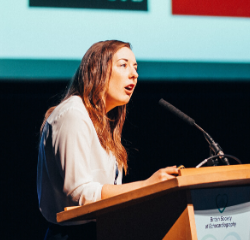
Dr Maria Paton, NIHR Clinical Lecturer at the University of Leeds,shares her journey into healthcare science and the opportunities available in clinical academia.
As Healthcare Science week is approaching, it seems like a great time to look back on how our roles have developed and continue to.
I love being a healthcare scientist, and feel very lucky to have stumbled into the career I have, even though being a clinical academic cardiac scientist means it’s not always followed the ‘usual’ route.
I say stumbled because I had virtually no idea what a cardiac physiologist was when I started. I remember our first day on the degree and being told we had an 8 week unpaid placement over the Summer every year, and starting to ponder the choices I’d made! All I had known was that I loved biology, particularly the cardiovascular system, and in all honesty I thought I would continue on to study medicine and become a doctor. By the time I had graduated though in 2011 I knew I was doing what I wanted, in a centre I loved (Leeds Teaching Hospitals Trust), with colleagues I really admired.
Having said that, I was young and eager and managed to persuade my boss to allow me to apply for a place on the Masters in Advanced Practice, already with the hope of running my own clinics one day. I was aware of a few driven physiologists that had become Professors, and had been taught by Dr Dave Oxborough at Leeds, so I was aware there were other pathways available to us than purely clinical roles. This was the time I started working within the Heart Failure clinic, which to this day has been the most supportive team I have ever worked with. Everyone was driven to work together to improve care, and innovation was really valued because most of the team also conducted research. I had always been interested in academia and had started guest lecturing on the undergraduate degree, but it was through working in the clinic that I saw people that combined clinical practice and research.
A fixed term job came up that offered me the chance to run one of the heart failure trials on pacemaker therapy, and I jumped at the chance. I still remember being told by more than one colleague that I was mad to be leaving a permanent roll for a temporary contract, even though I was only 26 at the time! This gave me the chance to work alongside Dr John Gierula, a physiologist who was doing his PhD. It would be safe to say the heart failure team and John took me under their wing and it was through their experience that I learnt about the National Institute for Health Research.
At the time, the drive to fund and support non-medical clinical academics had just begun, and the new NIHR/Health Education England integrated clinical academic (ICA) pathway had been developed. I was awarded a place on the first ICA internship, and got a pilot award from my trusts charitable body to gather data and prepare a doctoral fellowship application. I started my fellowship in 2017, and am incredible for the opportunities and training I’ve been given since.
It’s also been fantastic in those 4 years to see the clinical academic community in cardiac science grow and be part of it. We are very fortunate to have some amazing role models in healthcare science, many of whom have generously given me their support and encouragement, leading to me just being awarded a Clinical Lectureship (postdoctoctoral award) with the NIHR, for which I cannot thank them enough. One even created a Zoom meeting the whole day of my interview in case I had a wobble and needed a chat! I know we all really value being part of such a supportive group, and my single bit of advice to anyone considering a clinical academic, or even a new career pathway, would be to approach anyone you feel should be part of your team, to surround yourself with enthusiastic and knowledgeable colleagues, and please reach out!
I really hope that now more scientists than ever, all across the UK, know more of the routes and opportunities available to be involved in research and to be brave and feel able to shape what their career looks like. I love having a dual role and my slightly unusual career, and I hope in at least a small way, I can contribute to making that attainable for more people.